2008 Season in Review
October 29th, 2008
My 2008 Junior Pee Wee team proved to my most successful team in my five seasons of coaching youth football. Our potent offense averaged 27 points per game and held our opponents to 5.5 points per game. We were fortunate to have 4 players that learned on the job during our rough 2007 season who became the vital core to an undefeated squad. New players complemented these core players that executed our version of the single wing with amazing results. We had seven players score touchdowns in our six games and our fullback lead the league in scoring while our tailback lead in rushing yardage.
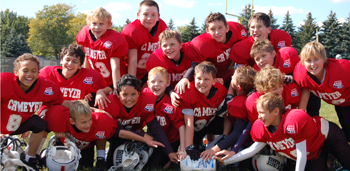
One of the lessons I learned from the 2007 season was we had more success with our less talented team when we began to spread the defense a little. Our best play by the end of that season was what we called “Super Power” – a trips look. When it came to the 2008 season I wanted to build upon that concept as well find ways to boost our output with more consistent big plays.
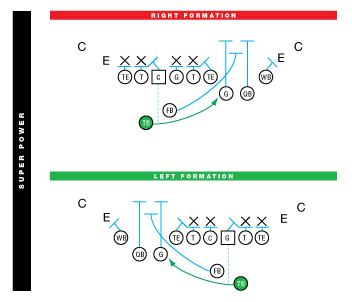
When I attended the 2008 Single Wing Conclave in Wilkes-Barre, PA I had some ideas in place about formations and plays, but the clinic cemented these ideas. I had already decided that I wanted to use a variety of formations based on Dr. John Ward’s ideas about leverage with offense. We aren’t allowed to use motion in our league and the best method for us would be formations. I set out to build a set of formations that would accomplish this goal, makes sense to what we were going to do and easy enough for our players to learn. I looked at numerous combinations and thought I was set until I saw Coach Deron Bayer’s Conclave presentation where he discussed a nasty split wingback. In my mind I was going to be using an unbalanced line single wing with the strong side end in a nasty split in order to push out the contain defender. Coach Bayer was using a split end and using the wingback in a 2×1 alignment from the offensive line where we would accomplish the same goal of widening the containment defender.
The idea of the split end also intrigued me. I used one in my first season running an unbalanced line direct snap double wing. I did like using the split end because we rotated three players at the position who could learn to block well enough. What I liked about this for the 2008 season was being able to widen out the cornerback making more room for our blockers and running backs. I further expanded this idea by using the split end on both sides of the formation with the same player. Our interior linemen were not going to be catching passes so it was not important for them to be eligible receivers. It was more important for me to widen the cornerback on the play side of our formations. After seeing coaches Denis Cronin’s and J. Michael Ranson’s presentations I was convinced to do this.
With an unbalanced line I also returned to a technique I used in the 2002 season where we used an unbalanced line with the right guard being our designated pulling lineman. With small numbers of players on our roster finding one capable player to fill this role was more realistic than trying to teach many linemen to pull successfully.
Formations
I settled on eight formations. At first it seemed like a lot but when I broke it down there were four main formations and these same formations were expanded to eight just by moving the split end to the opposite side. I also developed an easy method of naming them so the players would learn them easily. With only three players moving – the blocking back, the wingback and the split end, it did not take long to master the alignments.
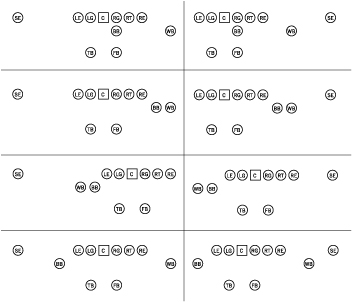
Generally we ran most of our offense with the blocking back and wingback lined up next to each other flanking the offensive line. We did line up with the blocking back tucked in behind the right guard area but these became our formations where we short-snapped to the blocking back.
We did use our double wing formations, however, infrequently. Normally we used this when the defender of our left end was causing problems when we ran the ball in that direction so we’d align in the double wing formation allowing the blocking back to put a shoulder into the defender to slow him down while he continued on his path to the linebacker.
The double wing also helped us decode what defenses might be doing if they were aligning based on where the wingback was or perhaps the blocking back. Usually it was the wingback but we did cause some confusion when we used the double wing formations.
No Huddle
My method of calling plays in a game was very simple. I’d shout out the formation and then use hand signals to call the play – series and point of attack. We averaged 10 more offensive plays than our opponents this season.
Power Series
The power series was our core series of plays. We began with the staple of essential single wing plays – tailback off-tackle, tailback sweep, fullback wedge, wingback counter and tailback sweep run/pass option.

The power off-tackle play was our bread-and-butter play. Initially we lined up in our base set and had the blocking back kick-out block the end man on the line of scrimmage, our wingback blocked the play side linebacker, the right guard and fullback lead into the hole. However, we noticed in our scrimmage that the containment defender was aligning on the outside shoulder of our nasty split wingback so we changed the wingback’s responsibility from the linebacker to kicking out the containment defender and having the blocking back blocking in the hole. Also we moved away from our base formation with the blocking back tucked in behind the right guard to lining up next to the wingback. This way we had the blocking back at the point of attack and he just went forward and we didn’t need to worry about the right guard and fullback all getting tangled up. The great thing was we could run this play from our base formation or with the two flanking the right side. We would also run it with the split end on the left side as well which meant we could run our go-to play from four formations if we wanted.
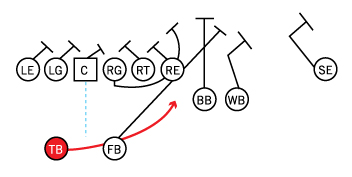
The fullback wedge had been a mainstay of mine for years but this year we changed it after our second game. The wedge blocking was coming together too slow for my liking so I decided to make this play a seam buck. Basically the line blocked straight ahead other than our right end who double-team blocked with the right tackle. Normally we face defenses that put linemen head up on guards and tackles so we were able to double-team the man over our right tackle. We directed the fullback to aim at this double team and look for the widest gap possible. This redesign allowed the play to hit quicker with more pockets of running room.
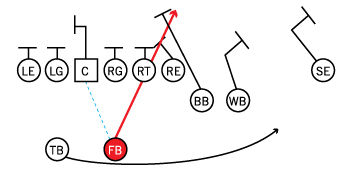
Originally the wingback counter play was part of the power series, but we decided to create an entire wingback series since our starting wingback was a talented runner as well as passer. Once we removed the wingback counter from the power series we added a fullback off-tackle play to the short side. This was a nice, quick, power play where the blocking was the same as our long side blocking for our wingback and blocking back but from the other side.
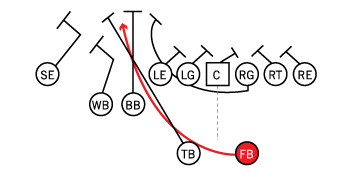
The long side tailback sweep play was very effective. After banging off-tackle with our powers, wingback counters and half spin counters, the defense would compact to a point where they were very susceptible to sweeps. Our tailback sweep to the long side was a powerful run with all our best blockers leading the way for our tailback. The short side sweeps with the fullback were not quite as effective but gained positive yardage each time it was run.
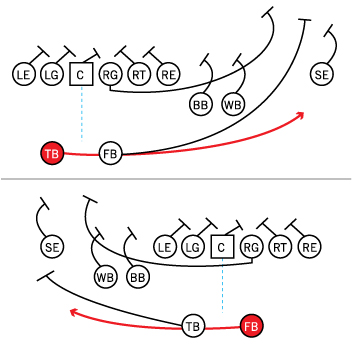
Our sweep pass was pretty basic and we did complete a few passes this season including a touchdown which was a first for my teams. It also worked on a couple of extra point plays. We did put the split end on the left side and had him run a pass route right up the middle as well. After the play was signaled in I’d tell the tailback who to throw to.
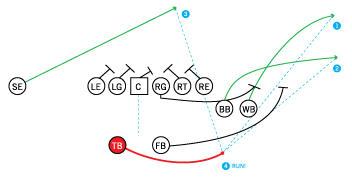
Wingback Series
Our wingback was a serious threat this season. He could pass as well. So after installing our core wingback counter play to the short side we expanded his role to an entire four play series. These included the wingback counter play to the long side as well as passes from each of these running plays.
Our wingback counter running plays start with a snap to the back nearest the wingback who took a step or two and executed an inside hand off to the oncoming wingback. The other back lead through the hole along with the blocking back while the pulling guard kick-out blocked the first bad guy he saw. We normally ran the wingback counter with the blocking back lined up next to the wingback but did run it from a double wing look as well. The blocking back’s role didn’t change – he lead into the hole, but now he was ahead of the tailback or fullback who were coming behind him.
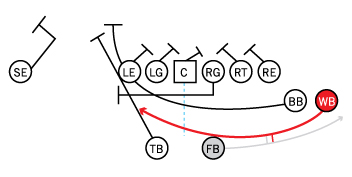
The most fun play we had in our offense this season was our wingback counter pass to the tailback. Instead of lead blocking, the tailback would run out into the flat where the wingback took an outside hand off from the fullback, stopped after two steps and passed to a wide-open tailback. This was a very effective extra point play for our team as well.
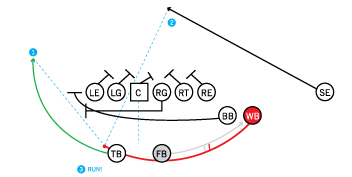
Half Spin Counter Series
This series of plays was an abbreviated version of the series that is available. I wanted a quicker counter play than the wingback counter that didn’t require a ball exchange among the back and Dr. John Ward’s series fit the bill. In addition I had numerous correspondences with youth coach John B. Reed of Virginia who was using the half spin counter series a great deal with his teams and knew I could do this with our team. We used the two off-tackle plays as well as the short snap to the blocking back play and the sweep pass play. The only difference in these last two plays from the power series plays is that the tailback and fullback conduct the half spin action.
The two off-tackle half spin counters start with the formation. We’d line up the blocking back and wingback next to each other on one side of the formation. By this point in the game the defense was very conscious of our power plays to this side which is exactly what we wanted because they’d begin to cheat to that side. So we’d run the half spin counter to the opposite side. The line blocking was the same as the wingback counter plays but the wingback stayed home and the tailback and fullback performed the half spin action.
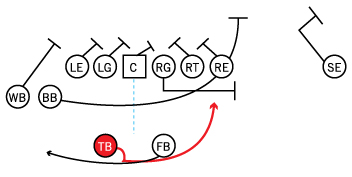
If we ran the half spin counter to the left then the fullback received the snap while his right foot stepped forward so his belly button was facing the sideline toward the tailback. He caught the snap and put the football on his left hip so the defense could not see the ball at this point – they should only see his right shoulder. The tailback went to the right behind the fullback faking as though he took the football from the fullback. After the tailback was past him the fullback would then push off with his left foot toward the left off-tackle hole.
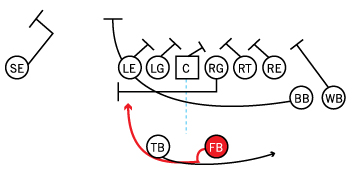
While this action was happening it gave the blocking back and right guard enough time to get to the left-off-tackle hole where the right guard kicked out the first bad guy he encountered and the blocking lead into the hole. If we ran the play to the right side, the tailback and fullback reversed jobs and the wingback and blocking back started from the left. The ball carriers needed to stay disciplined and follow their blockers after the half spin. We tried to have their eyes focused on the blocking back as he came into view and followed him to the point of attack.
The short snap play to the blocking back was a nifty play as well. We used it close to the goal line as well as for extra points. The half spin action behind the line of scrimmage was a perfect disguise for the sneaking blocking back running behind our seam buck blocking.
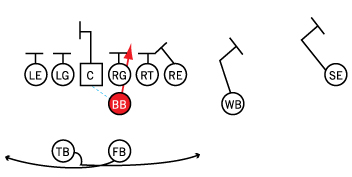
Adjustments
I think we had defenses guessing every play and that was a very important advantage for us. We had three different ways to attack the off-tackle hole. We had numerous formations that never tipped our hand. We usually ran to the split end side but didn’t have to either. Historically in our league opposing coaches really shifted to our wingback alignment. This year it didn’t matter they were always wrong. One team we faced did this and I’d call out the formation, watch the defense adjust and then call our play. Our formations forced them to react especially when the wingback and blocking back lined up together flanking the line. If a defense doesn’t do anything we ran power plays to this strength. If the adjusted then we ran half spin counter or wingback counter to the other side. This is in our favor and it’s a matter of execution at that point.
The second time we played this team they decided to take away our wingback alignment again but also the interior. We ran more half spin counters, sweeps and wingback counters. We felt we had a counter punch to whatever they threw at us.
The team we played in our scrimmage aligned their ends outside our wingback which we took advantage with our power off-tackle play. We didn’t have our half spin counter series installed yet so we ran the fullback up the middle, the tailback off-tackle and the wingback counter with an occasional sweep. When the played them in our regular season they put these ends inside our wingback in the first half therefore inviting us to sweep which we did. We also were able to run our half spin counters as well because their aggressive ends would come up field on the back side of our formation and the right guard would kick them out.
If you would like a copy of the complete playbook, please e-mail me.
There is video uploaded here and here. I really like the Vimeo website because the quality is better than Youtube.
Snap & Go!
Adam
adam_wesoloski at yahoo.com